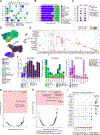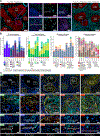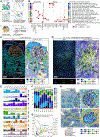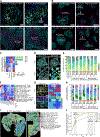Multi-omic profiling of follicular lymphoma reveals changes in tissue architecture and enhanced stromal remodeling in high-risk patients
- PMID: 38428410
- PMCID: PMC10966827
- DOI: 10.1016/j.ccell.2024.02.001
Multi-omic profiling of follicular lymphoma reveals changes in tissue architecture and enhanced stromal remodeling in high-risk patients
Abstract
Follicular lymphoma (FL) is a generally incurable malignancy that evolves from developmentally blocked germinal center (GC) B cells. To promote survival and immune escape, tumor B cells undergo significant genetic changes and extensively remodel the lymphoid microenvironment. Dynamic interactions between tumor B cells and the tumor microenvironment (TME) are hypothesized to contribute to the broad spectrum of clinical behaviors observed among FL patients. Despite the urgent need, existing clinical tools do not reliably predict disease behavior. Using a multi-modal strategy, we examined cell-intrinsic and -extrinsic factors governing progression and therapeutic outcomes in FL patients enrolled onto a prospective clinical trial. By leveraging the strengths of each platform, we identify several tumor-specific features and microenvironmental patterns enriched in individuals who experience early relapse, the most high-risk FL patients. These features include stromal desmoplasia and changes to the follicular growth pattern present 20 months before first progression and first relapse.
Keywords: B cell lymphoma; RNA-seq; cancer-associated fibroblasts; human lymph node; immunology; integrated analysis; multi-omic single-cell atlas; spatial proteomics; tumor microenvironment; tumor progression.
Published by Elsevier Inc.
Conflict of interest statement
Declaration of interests N.F. is the Chief Medical Officer of BostonGene, Corp., and all authors affiliated with BostonGene, Corp. were employees thereof at the time the study was performed. E.P., A.V., A.B., I.G., V.S., A. Sarachakov, P.O., N.K., and R.A. are inventors of patents related to this work. A.L.S. is an employee and shareholder of AstraZeneca. The follicular lymphoma samples collection conducted at NIAID, NIH, was an investigator-initiated project funded by NIAID, NIH.
Figures








References
-
- Rozenblatt-Rosen O, Regev A, Oberdoerffer P, Nawy T, Hupalowska A, Rood JE, Ashenberg O, Cerami E, Coffey RJ, Demir E, et al. (2020). The Human Tumor Atlas Network: Charting Tumor Transitions across Space and Time at Single-Cell Resolution. Cell 181, 236–249. 10.1016/j.cell.2020.03.053. - DOI - PMC - PubMed
MeSH terms
Grants and funding
LinkOut - more resources
Full Text Sources
Miscellaneous

